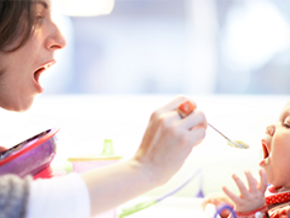
When to Provide First Solid Food
When to Provide First Solid Food
At the age of six months, your child will begin to show signs of readiness for the transition to first solid foods.
Author(s): Shen-Li Tan
At the age of six months, your child will begin to show signs of readiness for the transition to first solid foods. This stage, known as the weaning stage, may be a confusing time for both mother and child. As you go through this journey together, it is normal to have a few bumps along the way to find the right food for your child. After all, your child is tasting solid food for the first time, and will need encouragement at feeding time. Here are some suggestions to help you and your child in the journey of weaning.
- To reduce the risk of allergy, be sure to support your child’s diet with breastfeeding.
- Ensure that your child can lift his or her head firmly and independently, as well as sit up straight with your help. This will help your child avoid choking on food.
- If your child is making chewing movements, he may be ready for his first solid foods.
- Growing teeth is another sign that your child may be ready for solid food.
- Look at your child’s habits. If your child is curious about your food, or reaches out to it, your child may be ready for solid food.
If your child shows most of the signs of readiness, you can try serving some baby solid food. Nutritious complementary foods such as rice, fish, meat, poultry, legumes, vegetables and fruits should be introduced to your child at 6 months of age.
CERELAC can be provided to diversify your child’s meals. With different variants to excite your child and an easily digestible texture that’s filled with nutrition, they are a great way to complement your child’s diet of first solid foods.
As your child tries solid food for the first time, remember to never force your child to eat solid food if your child refuses it. Instead, aim to encourage your child slowly with a positive attitude. Lastly, enjoy the time you spend together with your child. Bon appetite!
Related articles

Food allergies in children Vs intolerances—things to consider
Child allergies and intolerances can develop at any time. An allergy is our immune system’s reaction to a substance it thinks is harmful.
Shen-Li Tan
3 mins to read

Introducing your child’s first foods? Be prepared with this handy kit
Now the adventure really starts!
3 mins to read

Moving on to finger foods? Follow our child-led weaning checklist
Wondering when to start children’s food? Most children are ready to start trying at around six months.
Danial Ahmad, Author
2 mins to read

Starting an Adventure of Solid Food
At 6 months old, your growing child will begin to need more to meet their nutritional needs.
Shen-Li Tan
3 mins to read

Preparing a Hearty and Healthy Breakfast for Your Child
As your child eases into a steady routine of eating times, you can begin to build good eating habits.
Shen-Li Tan
2 mins to read

Getting the Right Macronutrients for Your Child
During your child’s growing years, it is important to have the right amount of nutrients to support that growth. Macronutrients are nutrients required in big quantities for our bodies.
Shen-Li Tan
3 mins to read

Managing your child’s iron intake
Taking care of your child’s nutritional needs can be challenging enough without the concern to address iron deficiency anemia.
Shen-Li Tan
3 mins to read

Will taking iron-rich food be too much for my child?
As a parent, you may be often worried about whether your child is getting enough iron daily. However, on the other hand, you may also be concerned about providing too much iron for your child.
Shen-Li Tan
4 mins to read

Partially Hydrolysed Protein vs Regular Cow’s Milk Protein: The Hard Facts
Milk is power packed with all sorts of nutrients for a growing child. And just like a superhero has his source of strength, your child can get a variety of vitamins and minerals from milk.
Shen-Li Tan
1 min to read

3 Ways to Make Your Child’s Meals Stress-Free
You’ve probably encountered this before. You’ve just made an effort to make the most excitingly delicious meal for your child.
Shen-Li Tan
3 mins to read

A Balanced Diet for Your Child
Your child’s nutritional needs should be varied in a balanced baby diet that provides energy and support your child’s rapid growth.
Shen-Li Tan
2 mins to read

Providing Micronutrients on a Daily Basis
Every day you give your child three meals and a snack or two.
Shen-Li Tan
2 mins to read

Developing Healthy Eating Habits
As your child grows older, you will begin to notice a big difference in your child’s eating habits.
Shen-Li Tan
3 mins to read

Bridging the Nutrition Gap
It’s important for your child to have a balance diet that’s nutrition filled during the transition to solid food.
Shen-Li Tan
3 mins to read

Vegetables for Your Child
Vegetables are one of the main food groups for your child. It is a great source of vitamins and minerals.
Shen-Li Tan
2 mins to read

Developing Your Child’s Eating Habits
Most children have their own ways to tell you whether they are hungry or full. How you respond to these cues will help your child understand your reactions and his own expectations.
2 mins to read

Watch our videos now!
When little children move on to solids, they still need just as much iron.
Danial Ahmad, Author
2 mins to read

Why does your child need micronutrients anyway?
There are a lot of important factors in ensuring your child’s healthy growth and development.
2 mins to read

Is Your Little One Vomitting? Learn Why and How to Handle It
In general, little one vomiting will freak you and your partner out.
Danial Ahmad, Author
4 mins to read
Related tools







